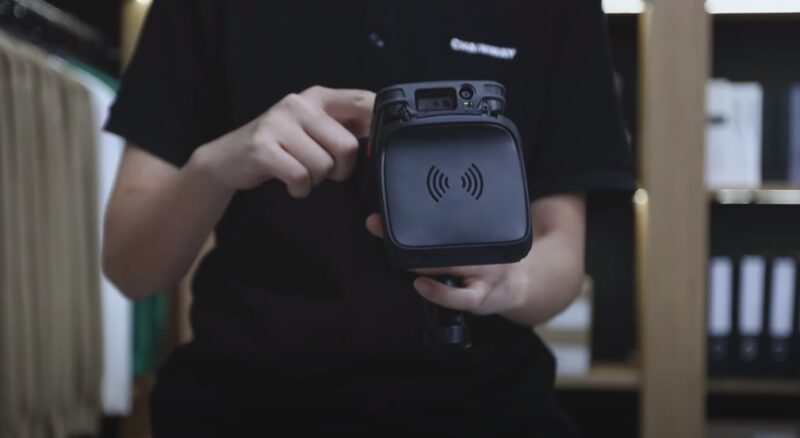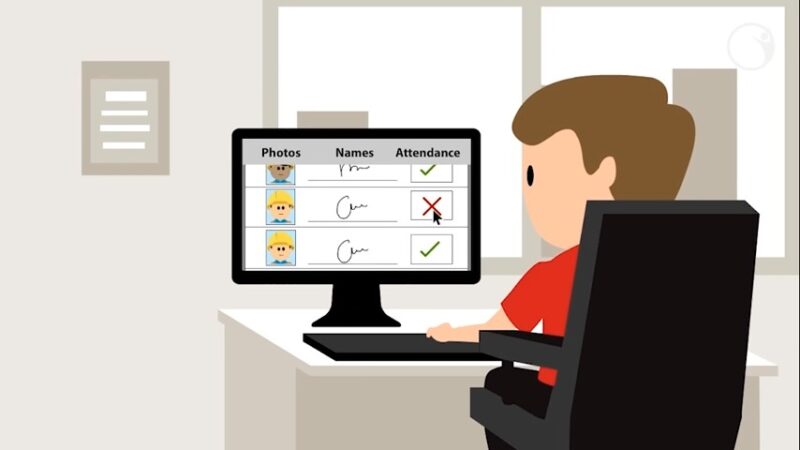RFID systems comprise three key components: tags, readers, and an antenna. The tag, typically carried by the employee, contains a microchip and an antenna, which communicates with the reader.
The reader, connected to an antenna, sends out electromagnetic waves. When the tag enters the reader’s field, the tag’s antenna receives the signal, activating the microchip to transmit its unique identification information back to the reader.
How This System Works?
This system functions through a coordinated interplay of tags, readers, antennas, and data management systems. Each component plays a vital role in creating a seamless tracking experience.
Tags and Readers

The main component of employee tracking system lies in the interaction between tags and readers. Here’s how this interaction unfolds:
- Tag Activation: Each employee carries the tag, usually embedded in a badge or ID card. When this tag comes within the range of an RFID reader, it gets activated. Active tags, powered by batteries, constantly emit signals, while passive tags are powered by the reader’s signal.
- Signal Transmission: Once activated, the tag transmits its unique identification data, which could include the employee’s ID number, to the reader. This transmission uses radio waves, a form of electromagnetic radiation, to communicate. Also, we have to add that this model is much more accurate than phone location tracking.
- Data Capture by Reader: The reader captures this transmitted data. Fixed readers placed at strategic locations capture data as employees pass by, while mobile readers can be used for more dynamic tracking within a facility.
Data Processing and Integration

After the data is captured by the reader, it undergoes processing and integration:
- Data Relay to Central System: The reader sends the captured data to a central processing system. This is typically done via a wired or wireless network connection.
- Integration with Software Systems: The data is then integrated into various software systems such as workforce management, security, or HR systems. This integration allows for a comprehensive understanding and application of the data.
- Real-Time Monitoring and Analysis: The integrated data can be monitored in real-time, allowing managers to see the current location of employees. This data can also be stored for historical analysis, useful for pattern recognition, workflow optimization, and compliance auditing.
Advanced Features
Modern systems come with advanced features that enhance their tracking capabilities:
- Zone-Based Tracking: By installing readers in different zones within a facility, businesses can track not just the presence of an employee but their movement across different areas. This is particularly useful in large facilities.
- Real-Time Alerts: The system can be configured to send real-time alerts if an employee enters a restricted area or if their tag hasn’t been read for an unusual length of time, indicating a potential security or safety issue.
- Integration with Other Security Systems: The tracking data can be integrated with other security systems like CCTV, enhancing overall security and situational awareness.
- Customized Reporting: The system can generate customized reports based on the data, such as attendance reports, movement logs, or security breach reports, aiding in decision-making and compliance.
Why You Should Use It?
- Enhanced Security: By tracking employee movements, businesses can ensure only authorized personnel access sensitive areas. This is crucial in industries where security is paramount, such as defense, pharmaceuticals, and finance.
- Efficiency in Operations: The tracking automates the monitoring of employee attendance, location, and movement. This automation reduces manual labor and errors associated with traditional tracking methods, like punch cards or manual sign-ins.
- Safety Compliance: In industries like construction or manufacturing, where employee safety is a critical concern, RFID tracking helps in quickly locating individuals in case of an emergency, ensuring timely response and adherence to safety protocols.
- Data-Driven Decision Making: It provides real-time data on workforce movement and utilization. This data can be analyzed to optimize workflows, reduce bottlenecks, and improve overall operational efficiency.
When to Use it?
- When High Security is Needed: In environments where security breaches can have severe consequences, RFID tracking ensures that only authorized personnel have access to restricted areas.
- For Large Facilities: In large workplaces, like warehouses or hospitals, manually tracking employee location is impractical. These systems efficiently manage this, saving time and resources.
- For Compliance with Safety Standards: Industries with strict safety regulations can leverage RFID to ensure compliance, as it provides an auditable trail of employee movements and activities.
Tools Needed
- Tags: These are attached to employee badges or uniforms. Active tags are used for long-range tracking, while passive tags suffice for shorter distances.
- Readers and Antennas: Readers capture data from tags. Fixed readers can be installed at strategic locations, while mobile readers offer flexibility in tracking on the go.
- Integration Software: This software integrates data with existing systems like HR management or security systems, allowing for seamless data analysis and application.
- Data Analytics Tools: To make the most of the data collected, businesses need analytics tools that can process and interpret data, providing actionable insights.
Additional Details
- Privacy Considerations: It’s vital to balance the benefits of tracking with employee privacy rights. Transparent policies and employee consent are essential.
- Environmental Factors: RFID systems can be affected by physical and environmental factors like metal surfaces or electronic interference. It’s important to consider these when implementing it in a particular setting.
- Cost-Benefit Analysis: While these systems can be an investment, the long-term benefits often outweigh the initial costs. Businesses should conduct a thorough cost-benefit analysis to determine the viability of tracking in their operations.
- Future-Proofing: As technology evolves, choosing a system that can adapt to future advancements ensures long-term viability and continued benefits.
Tags: Active vs Passive
![]()
These tags come in two main types: active and passive. Each has unique features and applications in employee tracking.
Active Tags
Active tags are powered by batteries, enabling them to transmit signals over longer distances. They are ideal for large-scale environments where real-time tracking is essential. However, their higher cost and need for battery replacements are potential drawbacks.
Passive Tags
Passive tags, on the other hand, have no internal power source. They are activated by the electromagnetic energy from the reader. While more cost-effective and maintenance-free, their shorter range limits their applicability in extensive tracking scenarios.
Readers: Fixed vs Mobile
The choice between fixed and mobile readers significantly impacts the efficiency of an employee tracking system.
Fixed Readers
Fixed readers are installed at strategic locations, like entry/exit points or specific zones within a facility. They provide constant monitoring of tagged employees as they move through these points, ideal for attendance tracking and access control.
Mobile Readers
Mobile readers, used in handheld devices or vehicles, offer flexibility in tracking. They are particularly useful in dynamic environments where fixed reader placement is impractical. These readers can actively track employee movements throughout the facility.
Integration with Other Systems
For maximized efficiency, tracking systems are often integrated with other technological systems.
Integration with Access Control Systems
This technology works seamlessly with electronic access control systems. This integration allows for automated entry management based on employee location and authorization, enhancing security and operational flow.
Synergy with Workforce Management Software
Integrating data with workforce management software provides comprehensive insights into employee productivity and behavior patterns. This synergy facilitates better scheduling, resource allocation, and overall management efficiency.
FAQs
What is an example of RFID for locating and tracking people?
RFID or Radio Frequency Identification is a technology that uses radio waves to identify and track objects or people that have RFID tags attached to them. An example of RFID for locating and tracking people is in hospitals, where RFID tags can be used to monitor the location and status of patients and staff.
Is RFID the same as GPS?
No, RFID and GPS are different technologies that have different purposes and capabilities. RFID uses radio waves to communicate with RFID tags, which can store and transmit data. GPS uses satellites to locate and track GPS-enabled devices, which can receive and calculate their position. RFID works well for short-range identification and tracking, while GPS works well for long-range navigation and tracking.
Is RFID better than GPS?
It depends on the application and the requirements. RFID and GPS have their own advantages and disadvantages, and they can be used together to create hybrid solutions. RFID is better than GPS for applications that need fast and accurate identification and tracking of items or people in a fixed area, such as warehouses, factories, or hospitals. GPS is better than RFID for applications that need global and continuous location and tracking of assets or vehicles, such as cargo, shipping, or transportation.
Is there RFID crime?
Yes, there is a possibility of RFID crime, where criminals use RFID readers or scanners to steal personal or financial information from RFID-enabled cards or tags. However, the actual incidence and impact of RFID crime is very low, as most RFID systems use encryption and authentication to protect the data. RFID crime is also not worth the effort for thieves, as there are easier and more profitable ways to commit fraud or identity theft.
How do criminals use RFID readers?
Criminals can use RFID readers or scanners to capture the data transmitted by RFID-enabled cards or tags. These readers can be bought online or built from common components, and they can be hidden in a backpack, briefcase, or handheld device. Criminals can then use the stolen data to clone the cards or tags, or to make unauthorized purchases or access.
Can cellphones detect RFID?
Yes, some cellphones can detect RFID, if they have a built-in NFC or Near Field Communication device. NFC is a form of RFID technology that operates on the same frequency and protocol as some RFID systems. Cellphones with NFC can act as RFID readers or tags, and they can communicate with other NFC-enabled devices or RFID tags. However, NFC and RFID are not fully compatible, and cellphones with NFC cannot detect all types of RFID tags.
Summary
RFID location tracking for employees is a powerful tool that bridges the gap between operational efficiency and workforce management. Its ability to provide real-time location data, integrate with various systems, and adapt to different industrial needs makes it invaluable in today’s fast-paced business environment.